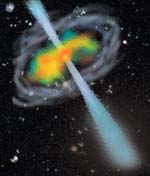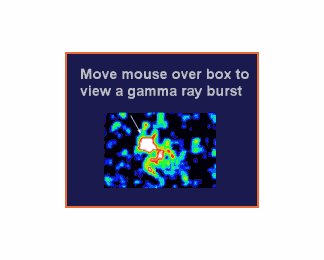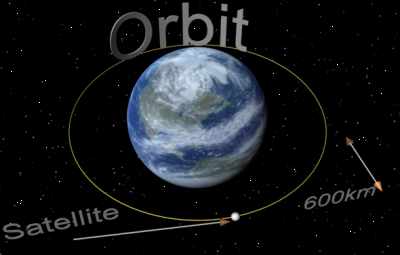



Energy is one of the most fundamental concepts in physics, and applies
to almost everything we do. XMM is no exception. Launching a satellite
like XMM into orbit requires a great deal of work. This is initially
converted into the kinetic energy of the rocket, and then into
increasing the gravitational potential energy of the satellite. The
X-rays which XMM is designed to detect, are one of the most energetic
forms of electromagnetic radiation, and are typically produced in high
energy situations, such as the gamma ray burster shown above, and in
quasars, both of which are discussed below.

Physical work and energy are closely related - if you do physical
work, such as running upstairs, you use energy. How much energy? Well,
we know that in a closed system energy is always conserved, that is,
it cannot be created or destroyed, only converted from one form into
another. In this case the energy used by your body in running upstairs
is converted into a gain of gravitational potential energy given by
mg![]() h, where m is your mass, g is the
gravitational acceleration at the surface of the Earth, and
h, where m is your mass, g is the
gravitational acceleration at the surface of the Earth, and ![]() h is the vertical distance you've climbed.
h is the vertical distance you've climbed.
Say you climb up one floor - a distance of 4m vertically - and you have a mass of 60kg. Since g=9.8 ms-2, the gain in potential energy or PE = 60x9.8x4 = 2352 J.

Have a guess how many times you'd have to run upstairs to burn up the energy(ie. the calories) in a Mars Bar?
The answer is surprising.
But why might this calculation be inaccurate? What assumption has been made?
Click here for the answer.
What if you walk upstairs instead of running?
The answer helps describe the idea of power.
The recommended energy intake as food is 2500 kcal per day for men and 2000 kcal per day for women. Given the first answer about how many times you need to run upstairs to use the calories in a Mars Bar, not much of this is used up doing physical work. What does most of our energy intake do?
Click here for the answer.
How much energy was needed to launch XMM into orbit?
As an approximation, we could use the same formula as we used in the
running upstairs calculation: gain in PE = mg![]() h, where now m = combined mass of the Ariane rocket and XMM
satellite, g is the gravitational acceleration at the Earths surface
as before, and
h, where now m = combined mass of the Ariane rocket and XMM
satellite, g is the gravitational acceleration at the Earths surface
as before, and ![]() h is the vertical height of the
XMM orbit above the Earths surface.
h is the vertical height of the
XMM orbit above the Earths surface.
The mass of XMM is 3.8 tonnes, the mass of the Ariane rocket is 750 tonnes, the height of XMM's orbit at its closest approach to Earth is 7000km, and the radius of the Earth is about 6400 km.

However, this formula neglects several effects which are now important. What energy have we omitted?
Click here for the answer.
POWER.
Anything that is using or emitting energy has a power value that describes how fast the energy is being used or emitted; power is the rate at which energy is used.

IMAGE - An image of gamma-ray burst GRB 970228 obtained with the BeppoSax Observatory. The false colour image shows the residual intensity in X-rays a few hours after the burst of gamma-rays.
The most powerful objects known in the Universe are gamma-ray bursts. Every day, one of these enigmatic bursts is detected from a different part of the sky. Their origin is in distant galaxies, but what causes them is unknown (it could be colliding neutron stars or "hypernovae"). They only last for about a minute, but during that brief time they outshine whole galaxies, supernovae, or anything else we know, with a power output of about 1045 W. This is 1018 times the power output of the Sun, or a million times the power output of the whole Milky Way Galaxy.
The most energetic objects in the Universe, defined as emitting most energy in total over their lifetimes, are QSOs (quasars). The total energy in a gamma-ray burst is 1045 W x 60s = 6x1046 J. This is only about 100 times more than the total energy output of the Sun over its lifetime of 10 billion years. A bright QSO has a lower power output of about 1040 W but lasts for at least 107 yrs, giving a total energy of 3x1054 J (ie 1010} times the total energy output of the Sun). This QSO energy is derived from the PE of matter continuously falling in the gravitational field of a massive black hole.
Quasars in these pages.
Learn more about Quasars in these pages. A simulation of launching a projectile into orbit A diagram showing the orbit of XMM
The End of the WORK AND ENERGY topic.

